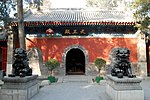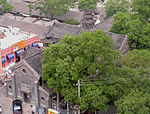Changchun Temple
Buddhist temples in Beijing

The Beijing Changchun Temple (Chinese: 北京长椿寺; pinyin: Beijing Changchun Si) is a Buddhist temple in Xuanwu District, Beijing, China. The temple also houses the Xuanwu Cultural Museum.
Excerpt from the Wikipedia article Changchun Temple (License: CC BY-SA 3.0, Authors, Images).Changchun Temple
Changchun Str, Xicheng District Guang'anmennei (首都功能核心区)
Geographical coordinates (GPS) Address External links Nearby Places Show on map
Geographical coordinates (GPS)
| Latitude | Longitude |
|---|---|
| N 39.891388888889 ° | E 116.35805555556 ° |
Address
北京长椿寺
Changchun Str
100032 Xicheng District, Guang'anmennei (首都功能核心区)
Beijing, China
Open on Google Maps











